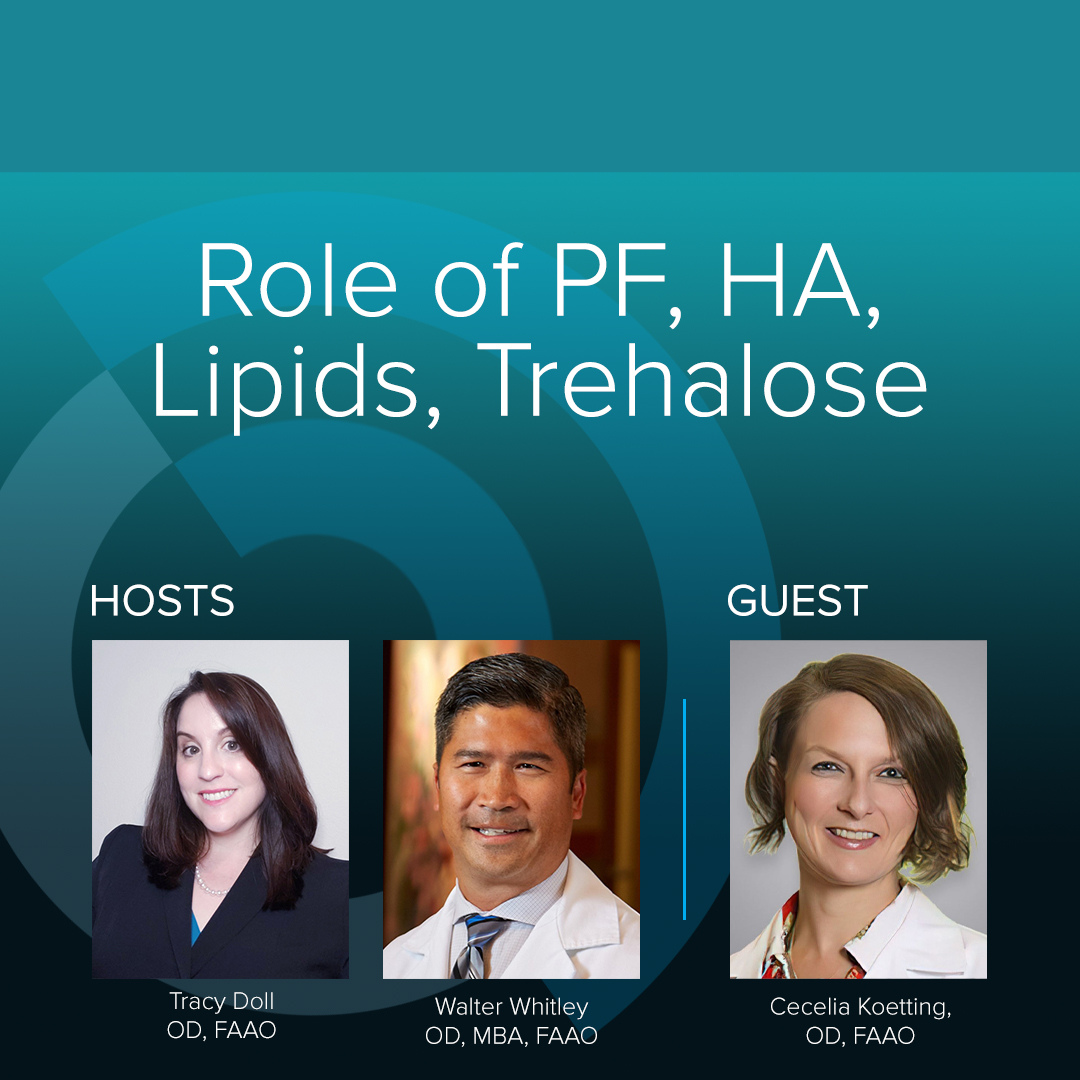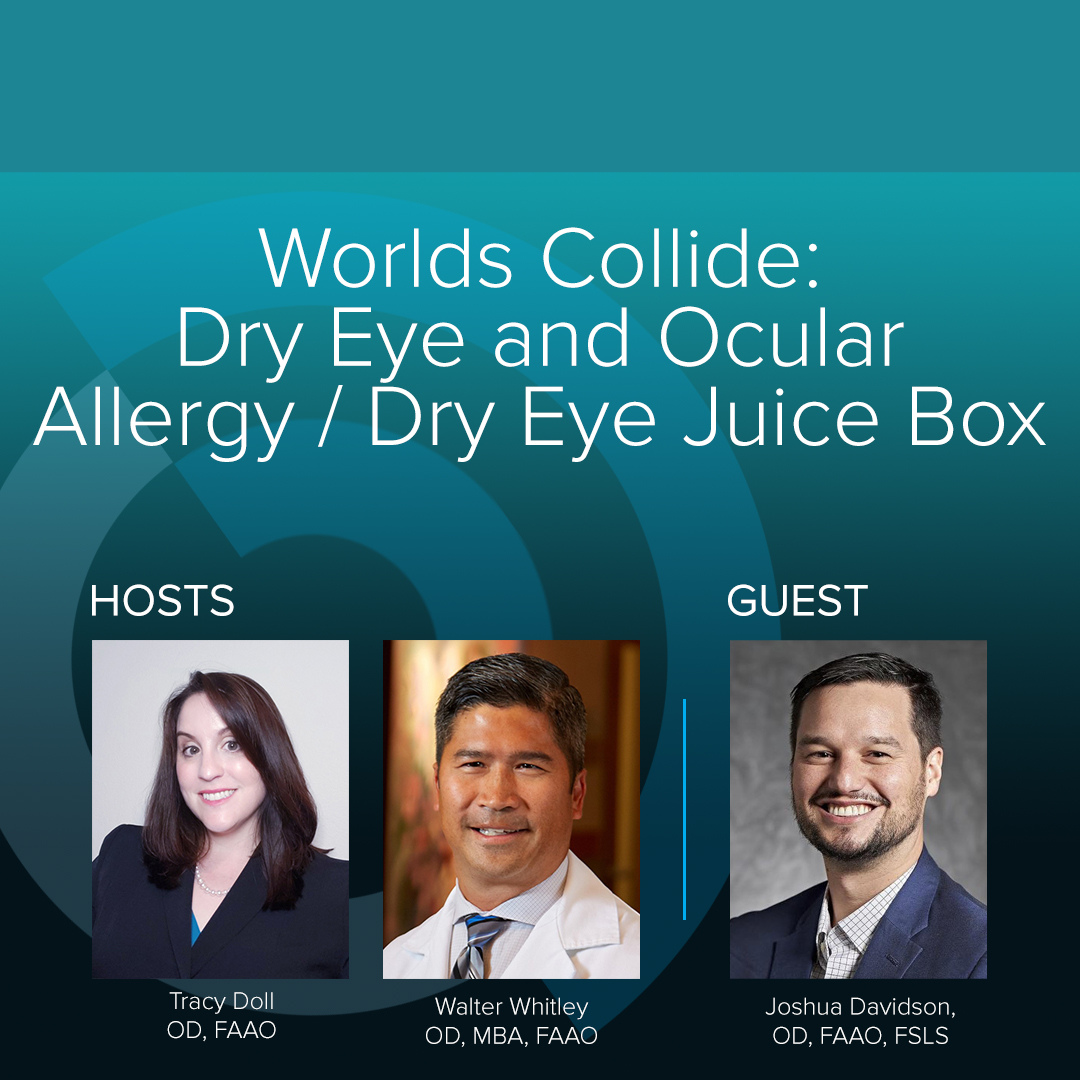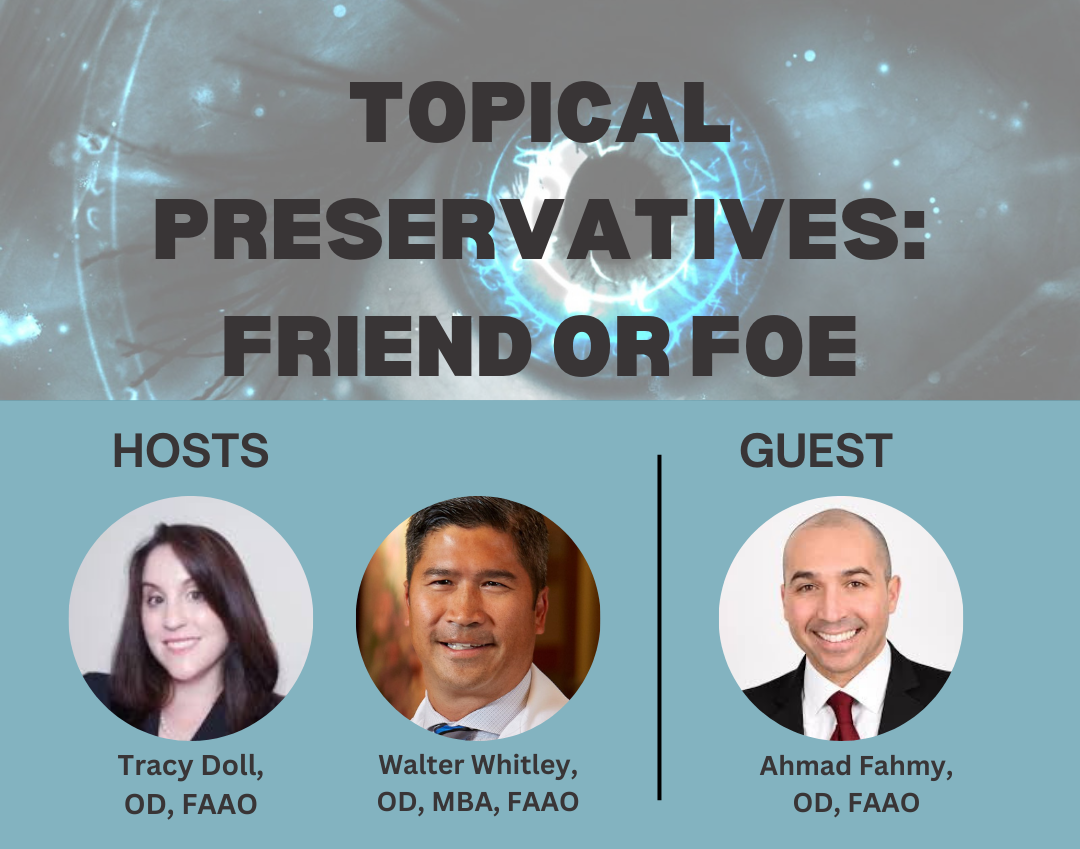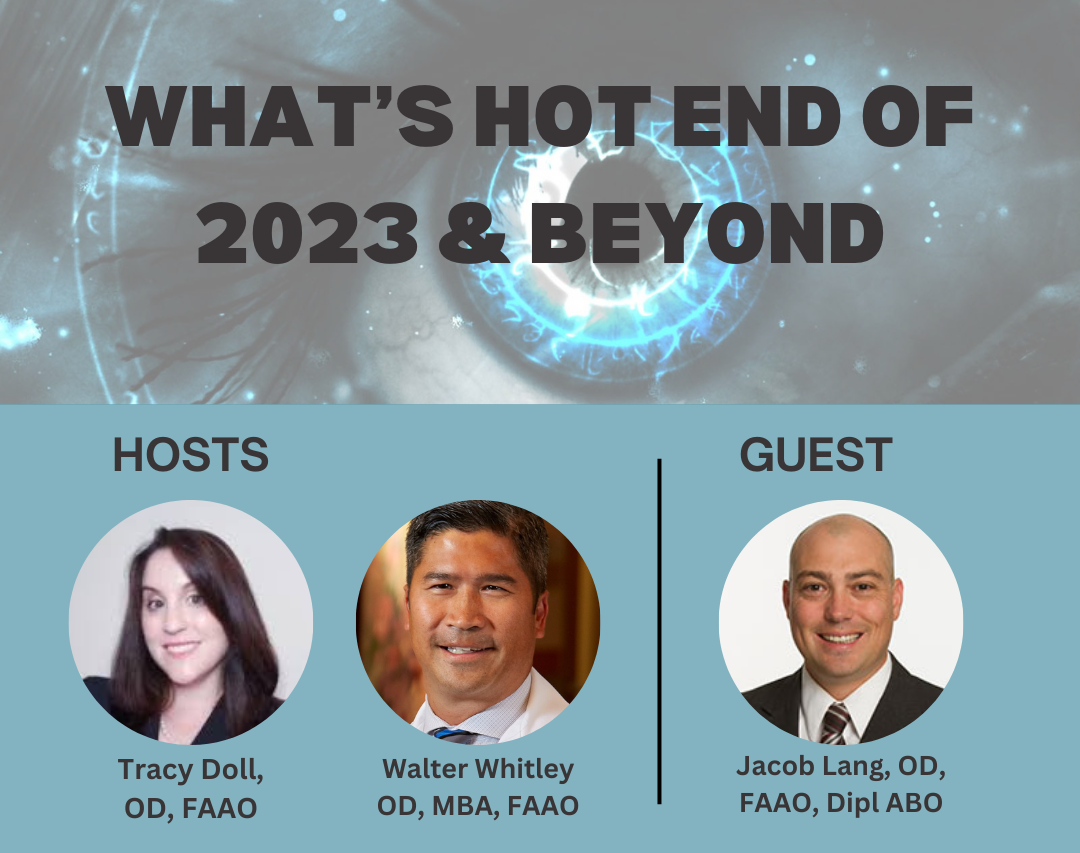Episode Transcript
[00:00:00] Speaker A: Welcome to the Dry Eye podcast series. Click on dry Eye, your insider path to the most exclusive dry eye topics. The series will raise awareness about the current and future state of ocular surface disease. The podcasts will focus on a variety of topics. Before we get to our next episode, here's a quick word from our sponsor.
In today's episode, we have the pleasure of speaking with Cecilia petting from hindsight Eye care center in Denver, Colorado. Now, I've been Cecilia for many years, actually, waltz hired just a few short years ago, right?
[00:00:38] Speaker B: That's right.
[00:00:39] Speaker A: Is that great? Tell us more about that.
[00:00:41] Speaker C: Almost a decade ago. I can't believe it's been so long.
[00:00:45] Speaker A: Wow. So that's exciting that you're out in Colorado now. When did you make that move?
[00:00:49] Speaker C: Yeah, so I made the move about six, seven months ago. And it's been really nice. Good ski season.
[00:00:57] Speaker A: So tell us about this current practice that you're in.
[00:01:00] Speaker C: Yeah, so the practice that I'm in is myself, essentially, and one full time ophthalmologist, who's a general ophthalmologist does a little bit of every kind of surgery, was previously military. So we've got a few part time docs that are also in there, an MD and an odd. But we do a little bit of everything, a lot of medical, a little bit of primary care, which is new to my world, hadn't done that, too much contacts made their way back to me. And lots of dry eye.
[00:01:33] Speaker B: Everybody has dry eye until proven otherwise.
[00:01:37] Speaker C: Especially here in Colorado.
[00:01:39] Speaker B: Yeah, I mean, when you and I were at the beach, we saw a lot of dry eye there. But now you're in Denver and I'm in Reno, Nevada, up by Tahoe, and we still get a lot of dry eye. So multifactorial. So can you tell us more as we get into this? How would you describe the need to disrupting the vicious cycle of dry eye at multiple points?
[00:02:00] Speaker C: Oh, I think it's absolutely needed. So we know that when we talk about dry eye, if you look at the Dus report, it breaks it down into aqueous deficient versus evaporative dry eye and then talks about there being a mix. I feel like majority of people are probably a mix, and that's because it's multifactorial. There's multiple areas where patients are getting affected. Both environmental medications, masks, talk about all of these different things. So we really have to disrupt it at multiple points within that cycle to get our patients back on board to where they need to be.
[00:02:37] Speaker A: So how do you prioritize the different entry points of protection, hydration and lubrication. So is it different for mild patients versus your more severe or moderate patients?
[00:02:49] Speaker C: Yes and no. I mean, there's a lot of foundational work that I think needs to be done with our patients and just the general eye health we are so used to. Everybody knows to brush their teeth, right. But not everybody knows that they should be cleaning their eyelids and they should be doing warm compresses proactively using artificial tears as opposed to reactively. Right. So I think that that's a very good basis that I have and I try to instill on my patients, regardless the level of their dry eye, is that we should be doing these things and then make the adjustments based on their particular problem and what I'm seeing as far as what needs to be addressed for them.
[00:03:35] Speaker A: A really great response. There's something for everybody at different levels, and those foundational things are really super duper important. I agree.
What role do you think the artificial tears play and how do you decide which one's best for which patient?
[00:03:51] Speaker C: I think that artificial tears are, we know it's not going to fix the problem, especially in many of these multifactorial patients that have lots of different issues going on as far as like meibomian gland issues and blepharitis, but it is still something that should be used. So I tend to pull the trigger on artificial tears with everyone. I think that every, especially in Denver, everybody should be on an artificial tear and should be cleaning their lids. Those are two. Those are two very good gimmes. And I like to, especially in those patients who may or may not have any signs or symptoms of dry eye, I like to use something that is more versatile.
And I also kind of tend to stick with those a lot of times with all of my patients anyway, because I think, as I've already mentioned, I feel like everybody's a combination of the types of dry eye. So something that's going to have some kind of maybe lipid layer replacement as well as an aqueous layer replacement. So I like to have something that's got a combination of the two.
[00:04:59] Speaker B: So did you just say that you, every one of your patients in your practice, you prescribe an artificial tear and lid cleansers? Because I love it.
[00:05:08] Speaker C: I agree.
[00:05:09] Speaker A: I do.
[00:05:10] Speaker C: I do. I may have learned from one of the best. So, you know, I have absolutely started doing that with every single patient that makes their way into my room, regardless if they have a complaint or not.
[00:05:21] Speaker B: Yeah, I mean, it just affects everybody. And so just being proactive. I loved how you said that, because it's going to affect them someday or another, and to bring it to light for them is, does your vision ever change or fluctuate throughout the day? And if they say yes, we know it's a tear film issue, and so we're going to prescribe the appropriate therapy. We know that there's a lot of different artificial tears that's available. And you just mentioned the lipids.
What about preservative free? I mean, a lot of things come in bottles. I've gone away from preservatives. I mean, if I'm prescribing this can be preservative free artificial tears. What about you? What are your thoughts?
[00:05:58] Speaker C: No, absolutely. I agree. So, you know, say ten years ago, how many options did we have that were preservative free? Not very many.
Or indefinitely. Nowhere near as much as we do now. And we've got a lot more options in the types of preservative free, artificial tears. As far as what did they contain? When we talk about things such as hyaluronic acid, talking about povidone, making sure that they've got both an emulsion or something that's a lipid layer replacement as well as aqueous. So we've got so many more options now. So I think it is just so much easier to push that button and say it should be preservative free. And we really don't want to add anything onto our patient's ocular surface that may accidentally worsen. We know that when we're using even these, what we call safe artificial tears that have preservatives, if they use it at an accelerated rate or using it more than four times in a day, they may actually start to show signs of irritation from the preservatives that are in those artificial tears. I think just make it simple. Get away from the preservatives and don't add to a potential problem.
[00:07:16] Speaker A: So is there a tipping point, then, that you recommend if you've got a patient that's coming in and they're using an artificial tear four to, like, six times a day, is that kind of a place where you may want to, they might need to pull the trigger to do more advanced therapy?
[00:07:29] Speaker C: Yeah, exactly. And if they're already at four to six times a day, they're not doing anything. But they're showing me, you know, the artificial tears, probably nothing, fixing it, and they're showing me that it's not because they're using it that often and they're telling me that they're bothered enough by it to sit there and take the time to put something in their eye four to six times a day. So we really know that when they get to that point, we are, we're not helping them by just suggesting another artificial tear. Now, it doesn't need to say don't take the opportunity to make sure that what they're using is the most appropriate for them as well as is there something better that we could suggest and make sure that they're not adding to the problem by taking away any preservatives, but then also starting to elevate the treatment plan, like you mentioned, to really treat the underlying problem versus kind of just continuing to band aid it with an artificial tear.
[00:08:34] Speaker B: I bet twice a day, if patients are using it more than twice a day, I'm already asking questions. I'm being more aggressive looking, utilizing the standing to see what's going on. What about you, Tracy?
[00:08:45] Speaker A: Definitely, I would say because I'm more referral based, sort of the trigger is if you're using it more than four times a day, for sure, that you should, our clinic, you should definitely be seeing Doctor Dahl. So that's one of the points that we pick. But I love what you said about there being so many more options now because I feel much more comfortable in recommending things, not only just being ingredients, it's also kind of like the bottle types, too. So there's options out there that we didn't used to have bottles. We all we had was vials over patients with dexterity problems. Now we're moving that direction where you're already there. So hopefully sooner.
[00:09:19] Speaker C: And it's not even just the dexterity being, you know, seeing younger patients, a lot of them are more ego conscious, and so they're trying to make sure that they're not adding to the waste in the world. And so using something that takes up less landfill and or, you know, is reusable is something that's really important. But you're right. No. Now that we've got a lot of different options as far as the modality of the bottle or like the bottle itself, dexterity is better. The bottles themselves, I think there's a little few of us who may have gotten burned on some of the earlier iterations of these multi dose preservative free bottles because it was just not always user friendly or you may end up just dousing yourself in tears.
So they have definitely made an improvement. And I urge people to go and try them again.
It's not the same bottles we were introduced to five years ago, but there's.
[00:10:21] Speaker B: Many companies are coming out with newer products. The bottle is easier. As you mentioned, you started to allude to some of the ingredients, which I want to get back to. We're hearing more about trehalose. We're hearing about ha, we know about HP guar and combining with the lipids, as you mentioned, and propylene glycol. Can you speak to some of these ingredients and how they make a difference or do they make a difference?
[00:10:45] Speaker C: Yeah, and I think they do. It's kind of interesting because the more you start to see these things coming up and looking at them, we start to see that the trend is following a lot of what's going on in Europe or there's companies that are coming over from Europe and introducing their products here. So the povidone is a hydrating polymer that actually helps to decrease the dry eye discomfort. And it forms kind of like this protective matrix over the eye.
So it's helping with essentially the adherence of the drop as well as its can help to. There's this thought I was reading about it. It was kind of interesting. And you guys tell me if you've heard about this, but it's an insoluble crystals that conform due to a reaction with calcium.
There's calcium that's released from the damaged cells of the eye surface. And so it's helping to protect from these calcium crystals. So I hadn't heard a lot about that and I know we were getting ready to talk about it, so I started to delve a little bit more into it and was interested to hear how it actually works.
Now, I don't go thinking about that necessarily. I think about the more hydration portion of it, but it was kind of interesting to hear the science behind it.
And then trehalose, we've been hearing a little bit more about this as well. I don't know. Are you familiar with where it comes from, Tracy?
[00:12:17] Speaker A: Not the original source. I do have some patients that are, that are really the clinic loving it since it, since it just came over a few months ago, so. But. Exactly. Source that. I'll have to look that one up for you. So the idea.
[00:12:32] Speaker C: Oh, no, it's kind of, it comes from the rose of Jericho.
So the idea is it's this plant, right. And it's in the middle of the desert and it's a plant that it's, when there's no water, it looks like it's dead, but then water gets reintroduced and it blooms back up. So the idea it's doing the same thing to the epithelial cells. It's protecting the epithelial cells so that when they're in a state of hyperlos molarity and there's a decreased amount of fluid or hydration, they don't die. It's not atrophying. They're desiccating and they're shrinking, but they're still protected so that when they get back into an environment where water is reintroduced or hydration is reintroduced, they actually come back, which I thought was really cool. So it's not just an artificial tear, you know, ingredient. It's actually helping to protect those epithelial cells. So that. That is one that I was actually really excited to see come over and be in some of our tears. Over the last couple of months, we've had more of them pop up with that.
[00:13:40] Speaker A: I'm definitely going to be looking up that rose of Jericho. That sounds fascinating.
[00:13:44] Speaker C: Yeah, I know. I'm bored. It's. I thought it was kind of cool so I had to share it.
[00:13:49] Speaker A: I know you're making. You're making artificial tears super exciting right now.
[00:13:53] Speaker C: Right.
[00:13:54] Speaker A: I really want to go in and do dig a little bit deeper on this because I did not realize. Thank you so much.
[00:13:59] Speaker C: Of course. Of course. That's what we're here for, right. Is to share with each other.
[00:14:03] Speaker A: Right?
[00:14:05] Speaker B: Definitely. So thanks for sharing that because there's so many different ingredients that are out there. But when it comes to lots of ingredients, lots of products from both of you, I'd love to hear how do you all address or minimize retail confusion and what are steps that you can recommend from the staff to the providers to the patient in regards to making sure they're getting the product that you recommend?
[00:14:31] Speaker C: Yeah. So that's really important because it is just. It is too confusing. And I not even just for the patient, it is starting to get a little confusing, I think for us as well because there have been so many different things popping up like you mentioned as far as ingredients. So I think that having samples in the office or something, either samples or to sell an office, something where you're handing it to the patient and they see it and they know what they're going for and what they're looking for is really helpful.
They're able to not only try it or see it, they can recognize it when they go to the store to get it.
And then I also think as. As a doctor, don't over inundate them. If you hand them two things, say why one might be better than the other so that they, the patient understands the difference between the two if you're going to give them. But I wouldn't go beyond that. I think that once you try giving them more than two ideas of anything, let alone an artificial tear, they start to get a little bit lost in the mix and forgets which is which. So, giving a point, you know, what you want, why you want them to use this one? I like to give them a sample, like I said, and tell them exactly how they're going to use it and when to use it.
[00:15:53] Speaker B: Do you sell it out of your office?
[00:15:55] Speaker C: A few. There are a couple that we have in office, but.
[00:16:02] Speaker B: So which one? I'm going to put you on the spot because people want to know which one is Doctor Kenning, and I'm happy to share. Tracy will pay as well.
[00:16:09] Speaker C: Absolutely. We have preservative free oasis that we sell in office, and we also have retain MGD in office.
Those are the two that we currently sell in our practice.
[00:16:23] Speaker A: Tracy, I'm currently not selling yet. I'm on the fence, but I'm trying out the new ones that I've just kind of crossed over. But I am really liking the, some of the hyaluronic acid ones are okay. But I do make a point to tell people what I want them to get, and it's like a prescription. So I'm telling them, I am prescribing you this artificial tear.
[00:16:47] Speaker C: Even though we carry those in our office with some of the newer ones coming out, it's like, oh, do we need to, do we want to switch? Do we sell through what we have?
With tea's ivisia coming onto the market, I really like it, and I was able to get some early samples of it. You know, speaking of all of these things, it's got, it's, you know, not only a preservative free multi dose bottle, it's got povidone, hyaluronic acid, as well as trehalose in there. So it's kind of ticking all those boxes. And I, you know, I gave it to my staff to use. I've been using it and I've given it to patients to trial, and everybody's been coming back with it. So that's one of those ones. I think I may pull the trigger and either add in and rotate out one of the others just to keep it easy in our office.
[00:17:36] Speaker B: Yeah, Tracy and I, we both had those, the early samples of it and early experience. And so far, as you mentioned, patients have been very excited about that. And so that's what we're looking into. I'll commit as well. I carry the same thing, same products that Cecilia does within the practice. For me, it typically is going to be preservative free, but it has to address the lipid component or the evaporative dry eye.
One of the ones that I've been seeing a lot more is with the HP guar, the propylene glycol, and the lipid layer with the sustained complete PF, because it's preservative free, because it's for vapor dry eye. And so I haven't found a way to bring it in the office. But those are some of the things that I'm looking at whenever we're making that decision on what to give to patients, because if you can give it to them out of the practice, that's going to help alleviate the retail confusion. So now to switch what you just said earlier, and either of you can answer, so what if you don't have any samples? Because not all of us have all the samples. How do you go about it, Tracy, you mentioned that you'd write it on the script.
What about you, Cecilia?
[00:18:47] Speaker C: I have done before, back where we were previously, there were some people and someone I had talked with actually sending in a prescription to the pharmacy for the patient of what you want them to get.
That could be an option, but I think no matter what, it's something tangible, written or a sample. So I think that writing down exactly what you want to get, don't write down artificial tear. Don't write down preservative free artificial tear. Give them something written that has what you want them to get.
[00:19:19] Speaker B: Yeah.
[00:19:20] Speaker A: It can be as simple as pulling up a picture on your laptop and having them take a screenshot of it. Younger patients will do that, too, with.
[00:19:28] Speaker C: Other things that we don't carry in office and bring it up so that they can see it.
[00:19:32] Speaker A: Yeah, like, I don't carry blue eyeshadow. So for today, I had to find a cleaner for somebody because I don't do blues. So screenshot it. There you go.
[00:19:41] Speaker C: Easy to do.
[00:19:42] Speaker A: So you can do that with artificial tears, too.
[00:19:45] Speaker B: Well, there's so many different great products on the market, and we just highlighted a few of those and just wanted to appreciate you discussing with us, Cecilia, some of the things that help make your decision on what to prescribe. The preservative issue or preservative free, the ingredients itself. But the main thing is coming from you, we don't recommend the grab bag approach. That's the other thing I was getting at with the staff. I had a staff member, a patient would call up with symptoms of dry eye, and the staff goes, oh, we'll just try this brand, this brand, this brand. And just use it a few times. If it doesn't help, call us back. I'm like, wait a second. I don't even carry those brands, and I didn't recommend any of those.
They're on board as well. So, hey, any final pearls of wisdom that you have for us, Cecilia?
[00:20:32] Speaker C: Okay. Yeah, yeah. Don't hesitate to be proactive and definitely be poignant in your suggestions to your patients as to what you want them to use and exactly how to do it.
[00:20:45] Speaker B: Well, perfect. Well, thank you so much, Cecilia, for all your great insights in regards to the over the counter artificial tears and where it fits into all of our patients, whether being deliberate or for patients who have already been suffering as adjunct, too. So thank you so much.
[00:21:00] Speaker C: Absolutely. Thank you guys for having me.





